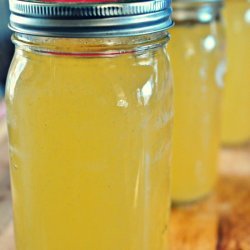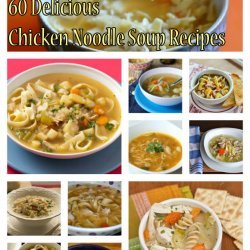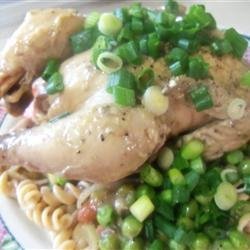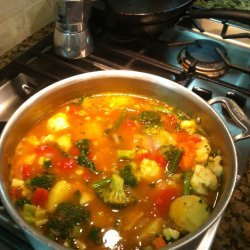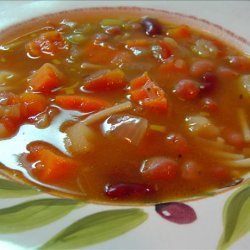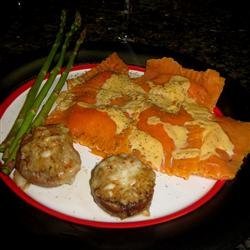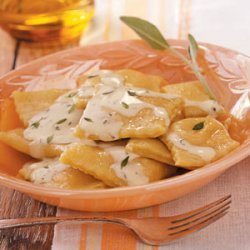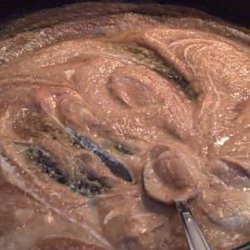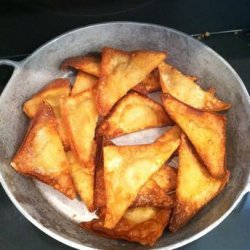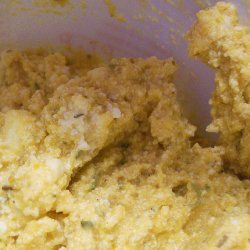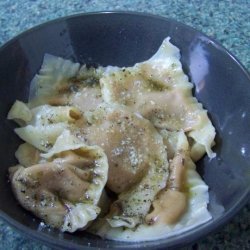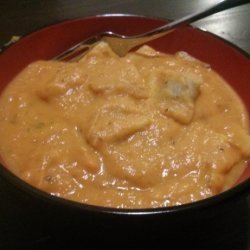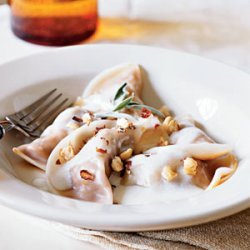Directions:
- Heat a saute pan over low heat and add 4 tablespoons of the butter. When the butter is foamy, add the cubed pumpkin and cook, stirring often to stop it from sticking and burning, until it softens and falls into a puree.
- Turn the pumpkin into a saucepan, add 1/2 of the cream and half the herbs and cook over a low heat for approximately 1 hour, or until the puree is thick and the liquid has evaporated. Stir occasionally to prevent scorching. Remove from the heat and beat in an additional 2 tablespoons of butter. Whisk in the beaten eggs, season, to taste, with salt and pepper and set a side to cool.
- On a floured surface, roll out the pasta as thin as possible. Cut into 2 sheets and brush 1 of them with egg wash. Using a teaspoon, place 24 equal mounds of the pumpkin puree on the egg-washed dough, about 2 inches apart. Cover the mounded dough with the second sheet of pasta and press around the mounds of pumpkin to seal the dough.
- Using a ravioli cutter or a sharp knife cut the ravioli. Dust a tray with semolina and place the ravioli on it.
- Bring a large pot of water to a boil, while you make the sauce.
- Prepare the sauce: In a saucepan, reduce the stock with the shallots to 1/2 cup. Add the remaining cream and reduce by half. Over a low heat, whisk in the remaining 4 tablespoons butter, a little at a time, over low heat. Strain the sauce into a clean saucepan and add the remaining sage and thyme. Season to taste with salt and pepper.
- Add the ravioli to the rapidly boiling water and cook for 4 to 5 minutes. Remove with a slotted spoon and drain. Add the ravioli to the sauce and bring just to a boil. Correct the seasonings.
- Divide the ravioli among preheated soup dishes and spoon the sauce over them. Garnish each serving with a fresh sage leaf. Serve immediately.
- A simple but delicious alternative sauce can be made from fresh unsalted butter, minced fresh sage, and a little freshly grated Parmesan.
- Spinach Pasta Dough:
- Wash the spinach carefully in 2 or 3 changes of water. Cut off 1 inch of the stems. Chop the leaves and puree them in a towel or napkin and squeeze the juice into a measuring cup. (Use a towel or napkin that you dont mind using only for this purpose, because spinach juice stains.) There should be about 1/4 cup of juice. Stir 2 tablespoons of the spinach puree into the spinach juice and reserve. Discard the remaining puree.
- Combine the flours in the food processor with salt. With the motor running, add the eggs, olive oil, and enough of the spinach mixture through the feed tube so that the dough forms a ball pressed together. Wrap the dough in plastic and let it rest at room temperature, for at least 2 hours.
- Divide the dough into 4 pieces and roll and cut 1 at a time as desired. Keep. The unrolled dough covered to prevent it from drying. Place any cut pasta on baking sheets that have been liberally dusted with semolina.
- Notes: The unrolled dough should be refrigerated after it has relaxed for 2 hours. Plan to use it within 24 hours. For best results, cut pasta may be refrigerated up to 24 hours before using or it may be left to air dry. For longer storage, Freeze the cut pasta, then wrap it tightly in plastic and return to the freezer. It will keep 3 to 4 weeks if carefully wrapped.
- Yield: 1 1/2 pounds
- Recipe courtesy Wolfgang Puck, The Wolfgang Puck Cookbook, Random House, 1986
- Regular Pasta Dough:
- Place the flours in a food processor fitted with a metal blade. Add the salt, eggs, and olive oil. Process until the dough begins to mass on the blade (about 1-2 minutes).
- Remove the dough from the processor and press it into a ball. Wrap in plastic and let rest at least 2 hours in the refrigerator before rolling and cutting. (Rolling the dough by hand is extremely tedious; with a small pasta machine and cutting attachment, you will save time and produce a much more uniform product.)
- Notes: The pasta can be made by hand or in an electric mixer fitted with a dough hook. For each of these methods, mix the dry ingredients together first, make a well in the center, add the wet ingredients and mix them together slowly until everything is combined well. Wrap in a plastic.
- Yield: 1 1/2 pounds
- Recipe courtesy Wolfgang Puck, The Wolfgang Puck Cookbook, Random House, 1986
- Chicken Stock:
- In a stockpot, place the chicken bones, then add all the remaining ingredients except the water. Add water to cover by 2 inches, bring it to a boil and reduce the heat. Simmer the mixture for 2 or 3 hours, skimming the surface scum form the stock as it collects.
- Strain the stock into a clean pot, and grease it thoroughly. Bring the stock to a boil, and reduce it over moderate heat to 2 quarters.
- Use the stuck immediately or let it cool to room temperature and refrigerate or freeze until needed.
- Notes: To make demi-glace chicken, duck, veal, etc., reduce stock until it is slightly syrupy and the flavor is concentrated.
- Yield: 2 quarts
- Recipe courtesy Wolfgang Puck, The Wolfgang Puck Cookbook, Random House, 1986
Nutrition Facts
| Amount Per 1 Serving | |||
| Calories | 1930.68 Kcal (8083 kJ) | ||
| Calories from fat | 988.13 Kcal | ||
| % Daily Value* | |||
| Total Fat | 109.79g | 169% | |
|---|---|---|---|
| Cholesterol | 647.65mg | 216% | |
| Sodium | 1369.81mg | 57% | |
| Potassium | 1725.79mg | 37% | |
| Total Carbs | 194.67g | 65% | |
| Sugars | 14.55g | 58% | |
| Dietary Fiber | 15.47g | 62% | |
| Protein | 50.65g | 101% | |
| Vitamin C | 50.5mg | 84% | |
| Vitamin A | 0.8mg | 28% | |
| Iron | 9.1mg | 50% | |
| Calcium | 431.4mg | 43% | |
| Amount Per 100 g | |||
| Calories | 98.32 Kcal (412 kJ) | ||
| Calories from fat | 50.32 Kcal | ||
| % Daily Value* | |||
| Total Fat | 5.59g | 169% | |
|---|---|---|---|
| Cholesterol | 32.98mg | 216% | |
| Sodium | 69.76mg | 57% | |
| Potassium | 87.89mg | 37% | |
| Total Carbs | 9.91g | 65% | |
| Sugars | 0.74g | 58% | |
| Dietary Fiber | 0.79g | 62% | |
| Protein | 2.58g | 101% | |
| Vitamin C | 2.6mg | 84% | |
| Iron | 0.5mg | 50% | |
| Calcium | 22mg | 43% | |
* Percent Daily Values are based on a 2000 calorie diet. Your daily values may be higher or lower depending on your calorie needs.
Find out how many calories should you eat.
Get Your Recipe of Health!
Follow RecipeOfHealth on Facebook!



